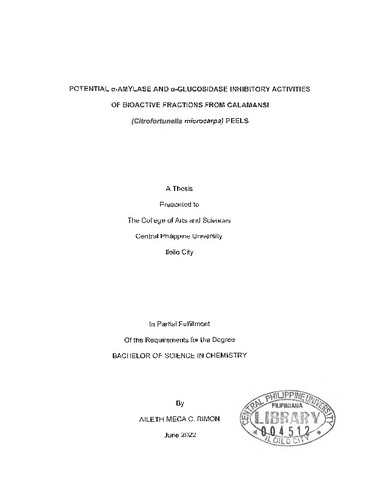Potential α-amylase and α-glucosidase inhibitory activities of bioactive fractions from calamansi (Citrofortunella microcarpa) peels

Page views
948Date
2022-06Author
Thesis Adviser
Defense Panel Chair
Share
Metadata
Show full item record
Abstract
Calamansi fruits are commonly used in the Philippines and the peels are discarded as wastes. Epicarpium of calamansi peels were selected for analysis in this study in order to determine their potential in vitro inhibition of α-amylase and α-glucosidase, enzyme markers of diabetes mellitus. The potential inhibition of the six fractions against α-amylase ranged from 6.5% to 34.2%, with the acetone-methanol (4:1) fraction having the highest percentage inhibitory activity of 34.2% ± 3.3. However, only two fractions showed inhibition against α-glucosidase with acetone-methanol (4:1) extract having the higher percentage inhibitory activity of 12.3% ± 1.7. Thus, epicarpium from calamansi peels have moderate to low inhibitory activity against α-amylase and α-glucosidase, respectively. Results of this study provide useful information for development of calamansi peels into nutraceuticals that could help with diabetes management.
Description
Abstract only
Suggested Citation
Rimon, A. M. C. (2022). Potential α-amylase and α-glucosidase inhibitory activities of bioactive fractions from calamansi (Citrofortunella microcarpa) peels (Unpublished thesis). Central Philippine University, Jaro, Iloilo City.
Type
ThesisSubject(s)
Keywords
Department
College of Arts and SciencesDegree
Bachelor of Science in ChemistryShelf Location
Filipiniana Theses 540.72 R468
Physical Description
vii, 35 leaves


